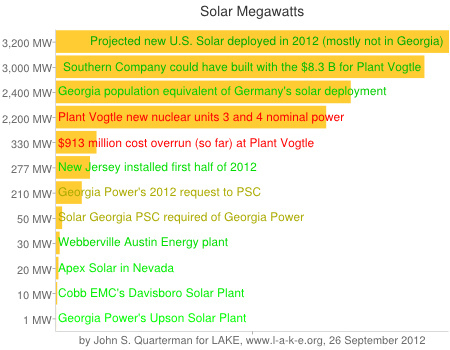If you’re quick, you may be able to sell solar from your roof to Georgia Power. If the PSC approves a pending request. If you get in before that new quota gets filled. And if you’re a Georgia Power customer. The rest of us? Not until the 1973 Georgia Electric Territorial Act is changed. Until then, Georgia will continue to lag way behind New Jersey in solar power.
Walter C. Jones wrote for the Augusta Chronicle today, Georgia Power plans to triple solar power use,
Georgia Power filed Wednesday seeking permission from state regulators to more than triple the amount of solar power it uses to generate electricity for its 2.4 million customers by swapping it for what was already planned from other renewable sources.
What “other renewable sources”?
The Georgia Power plan won’t affect rates because it is based on paying the solar providers what it would have paid the biomass provider, 13 cents per kilowatt hour, which is already figured into customer’s rates.
OK, that’s good, because it means biomass is well and truly dead in Georgia. But it also means Georgia Power isn’t very serious about solar, if all it’s doing is fiddling with accounting for the small amount of power biomass might have produced and not going for the real numbers solar can produce. OK, how many solar megawatts?
The giant utility’s request to buy 210 megawatts of electricity was applauded by solar advocates.
The solar capacity will serve roughly 26,000 homes — less than one-tenth of what the two new nuclear reactors at Plant Vogtle will produce.
Yet, as Sierra Club and Greenlaw point out in a press release of today,
“This is a great first step from Georgia Power to tap our tremendous
solar potential and make this clean resource a more significant part of our statewide power generation,” said Colleen Kiernan, director of the Georgia Chapter of Sierra Club. “But this is only a step. New Jersey installed 277 MW in the first half of this year alone and Georgia Solar Utility has proposed 2,000 MW by 2016, nearly 10 times the current proposal from Georgia Power and the GPSC. This proposal only scratches the surface—we can’t stop here and let our potential go to waste.”
 That’s right, New Jersey, much smaller and way to the north of here,
installed 277 MW in the first half of 2012 alone.
Even that is less than the
330 megawatts Georgia Power could have already deployed,
on time and on budget,
That’s right, New Jersey, much smaller and way to the north of here,
installed 277 MW in the first half of 2012 alone.
Even that is less than the
330 megawatts Georgia Power could have already deployed,
on time and on budget,
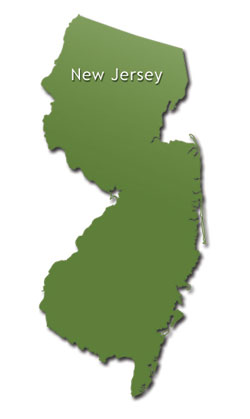 for the almost $1 billion the new nuke
cost overruns so far.
Georgia Power and its parent
Southern Company (SO) say only about part of that cost overrun
is due to them (the rest to contractors).
So this 210 MW is in that range.
But still way below
the 3,000 MW SO could have already built with the $8.3 billion
loan guarantee for the new nukes,
which is more than the 2,200 MW nominal capacity of the two new nukes
combined, if they ever go online.
Instead of playing late catchup,
how about leading the country for a change, Georgia Power and Southern Company?
for the almost $1 billion the new nuke
cost overruns so far.
Georgia Power and its parent
Southern Company (SO) say only about part of that cost overrun
is due to them (the rest to contractors).
So this 210 MW is in that range.
But still way below
the 3,000 MW SO could have already built with the $8.3 billion
loan guarantee for the new nukes,
which is more than the 2,200 MW nominal capacity of the two new nukes
combined, if they ever go online.
Instead of playing late catchup,
how about leading the country for a change, Georgia Power and Southern Company?
Georgia Power’s plan is to buy no more than 20 megawatts from any one supplier and to purchase 10 megawatts of so-called distributed power in new contracts each of the next three years from homeowners or property owners looking to make a little money from their roof space.
 Ten megawatts?
That’s only 666 times the 15 kilowatts I’ve got on my farm workshop roof!
I bet there are more than a few hundred home and business owners in Georgia
who would like to do this.
And many of them with the most roof space or acreage are connected via EMCs,
not directly to Georgia Power.
Ten megawatts?
That’s only 666 times the 15 kilowatts I’ve got on my farm workshop roof!
I bet there are more than a few hundred home and business owners in Georgia
who would like to do this.
And many of them with the most roof space or acreage are connected via EMCs,
not directly to Georgia Power.
“The program announced today offers a very limited program for homeowners and business owners to install solar on their own roofs,” said Rhone Resch, president and CEO of the national Solar Energy Industries Association. “Distributed solar must be allowed to grow at a rate higher than 10 megawatts per year in order to create a truly sustainable market and jobs across the state.”
The solar association has lobbied for a different arrangement that would allow property owners to rent their roofs to solar companies, which would sell the power back to them and then market any extra to Georgia Power or neighboring homes. Georgia Power opposes changing the law to allow that.
“The law” would be the
1973 Georgia Electric Territorial Act,
which says you can sell any power you generate to your one and only
electric utility, at the rate it chooses to pay you.
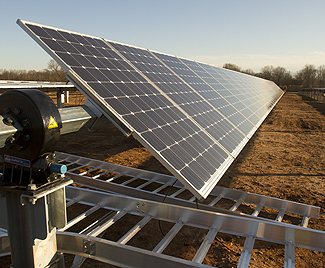 In New Jersey
a school can lease land to a solar company and lease back the 6.1 MW
of power produced.
Suppose
Lowndes High School wanted to do that, where everybody travelling I-75 would see it.
Nope, not in Georgia: the 1973 Electric Territorial Act says no.
There was an attempt in the legislature this year to change that, but
Georgia Power peddled the same old disinformation about solar power
and shut it down.
In New Jersey
a school can lease land to a solar company and lease back the 6.1 MW
of power produced.
Suppose
Lowndes High School wanted to do that, where everybody travelling I-75 would see it.
Nope, not in Georgia: the 1973 Electric Territorial Act says no.
There was an attempt in the legislature this year to change that, but
Georgia Power peddled the same old disinformation about solar power
and shut it down.
As Sierra Club and Greenlaw point out, and as Georgia Power says on its own web pages:
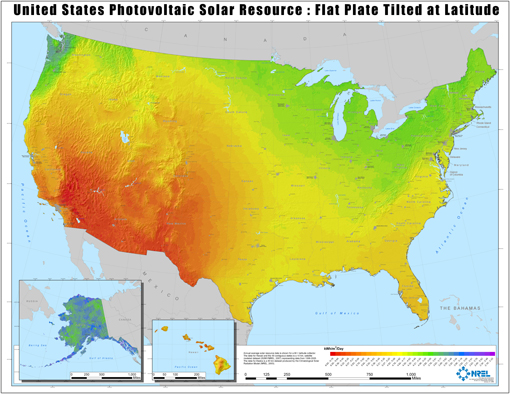
…insolation values in Georgia are significant enough to support solar energy systems in our state, with the southern two-thirds of Georgia having equivalent solar insolation values to most of the state of Florida.
And all of Georgia has more insolation (sunlight falling on the surface) than any of New Jersey. Let’s see, 2/3 of Georgia’s 57,919 land square miles is about 38,612, or more than five times New Jersey’s 7,419 land square miles. New Jersey doesn’t even have as many people (8.8 million) as Georgia (9.8 million). So why is Georgia so far behind in solar power? Maybe soon Georgia Power and Southern Company help us all deploy solar in Georgia like we could, maybe by helping us modify that 1973 Electric Territorial Law.
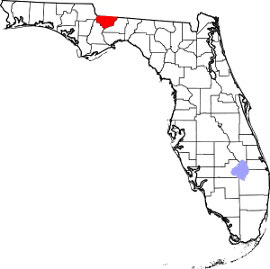 Where could the money come from?
In addition to all the
private venture capital looking for
solar projects?
Sierra Club and Greenlaw provide a clue:
Where could the money come from?
In addition to all the
private venture capital looking for
solar projects?
Sierra Club and Greenlaw provide a clue:
In 2008 alone, Georgia sent $2.62 billion out of state and to South America to import coal to be burned for electricity, at a cost of $270 per person statewide. Further, compared to multi-billion-dollar coal and nuclear plants, solar electricity is stable, and even declining in price, since there are no ongoing fuel costs or expensive facility retrofits.
Solar power can serve as a cost-effective alternative to traditional power generation in Georgia. Finally, solar power is a drought-proof energy resource that does not need freshwater resources, unlike coal-fired plants, which use hundreds of millions of gallons of water across Georgia each day.
 Coal, natural gas, and biomass
burn water.
So does nuclear.
Plant Vogtle already uses more water than all the agriculture in the surrounding
area, and
with all 4 units,
it will use more water than the city of Savannah.
So instead of throwing more water on the bonfire of coal, natural gas,
and nuclear, how about if we shift to no-water, no-fuel, no-pollution
solar and
wind energy starting now?
Coal, natural gas, and biomass
burn water.
So does nuclear.
Plant Vogtle already uses more water than all the agriculture in the surrounding
area, and
with all 4 units,
it will use more water than the city of Savannah.
So instead of throwing more water on the bonfire of coal, natural gas,
and nuclear, how about if we shift to no-water, no-fuel, no-pollution
solar and
wind energy starting now?
-jsq
Short Link:
